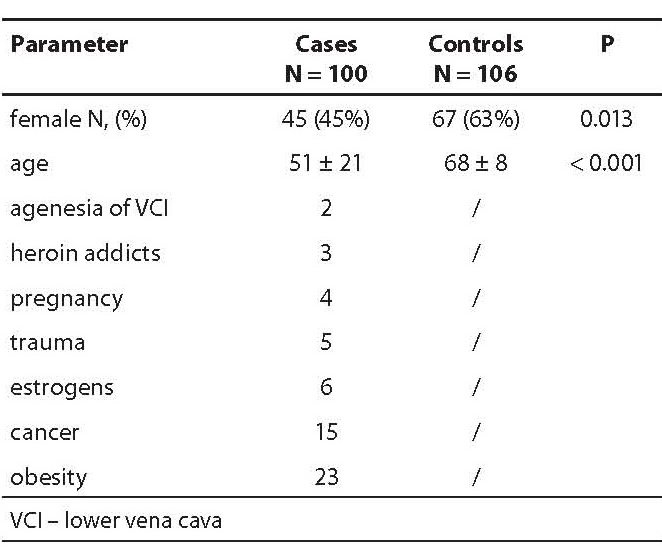References
1. Silverstein M, Heit J, Mohr D, Petterson T, O’Fallon W, Melton L. Trends in the incidence of deep vein thrombosis and pulmonary embolism: a 25-year population-based, cohort study. Arch Intern Med 1998;158:585-93.
2. Heit J, Petterson T, Farmer S, Bailey K, Melton L. Trends in incidence of deep vein thrombosis and pulmonary embolism: a 35-year population-based study. Blood 2006;108:430a.
3. Baker LW, Prajapat DK. Deep vein thrombosis in African and Indian patients. S Afr J Surg 1974;12:127-31.
4. Kniffin WD, Baron JA, Barrett J, Birkmeyer JD, Anderson FA. The epidemiology of diagnosed pulmonary embolism and deep venous thrombosis in the elderly. Arch Intern Med 1994;154:861-3.
5. White R, Zhou H, Romano P. Incidence of idiopathic deep venous thrombosis and secondary thromboembolism among ethnic groups in California. Ann Int Med 1998;128:737-40.
6. Hooper W, Holman R, Heit J, Cobb N. Venous thromboembolism hospitalizations among American Indians and Alaska Natives. Thromb Res 2002;108:273-8.
7. De Stefano V, Finazzi G, Mannucci PM. Inherited thrombophilia: pathogenesis, clinical syndromes, and management. Blood 1996; 87:3531-44.
8. Heit JA, Silverstein MD, Mohr DN, Tanya M, Petterson MS, O’Fallon WM, Melton LJ. Risk factors for deep vein thrombosis and pulmonary embolism a population-based case-control study. Arch Intern Med 2000;160:809-15.
9. Wheeler HB, Anderson FA Jr, Cardullo PA, Patwardhan NA, Jian-Ming L, Cutler BS. Suspected deep vein thrombosis. Management by impedance plethysmography. Arch Surg 1982;117:1206-9.
10. Rees DC, Cox M, Clegg JB. World distribution of factor V Leiden. Lancet 1995;346:1133-4.
11. Koster T, Roosendaal FR, de Ronde H, Briet E, Vandenbroucke JP, Bertina RM. Venous thrombosis due to poor anticoagulant response to activated protein C: Leiden Thrombophilia Study. Lancet 1993;342:1503-6.
12. Svensson PJ, Dahlback, B. Resistance to activated protein C as a basis for venous thrombosis. N Engl J Med 1994; 330:517-22.
14. Poort SR, Roosendaal FR, Reitsma PH, Bertina RM. A common genetic variation in the 3’-untranslated region of the prothrombin gene is associated with elevated plasma prothrombin levels and an increase in venous thrombosis. Blood 1996;88:3698-703.
15. Margaglione M, Brancaccio V, Giuliani N, D’Andrea G, Cappucci G, Lannaccone L, et al. Increased risk for venous thrombosis in carriers of the Prothrombin GA20210 gene variant. Ann Intern Med 1998;15;129:89-93.
16. Roosendaal FR, Doggen C, Zivelin A, Arruda V, Aiach M. Geographic distribution of the 20210G to A prothrombin variant. Thromb Haemost 1998;79:706-8.
17. van der Meer FJ, Koster T, Vandenbroucke JP, Briët E, Roosendaal FR. The Leiden Thrombophilia Study (LETS). ThrombHaemost 1997;78:631-5.
18. Martinelli I, Bucciarell P, Margaglione M, De Stefano V, Castaman G, Mannucci P, Mannuccio I. The risk of venous thromboembolism in family members with mutations in the genes of factor V or prothrombin or both. Br J Haematol 2000;111:1223-9.
19. Cattaneo M. Hyperhomocysteinemia, atherosclerosis and thrombosis. Thromb Haemost 1999;81:165-76.
20. Froost P, Blom HJ, Milos R, Gazette P, Sheppard CA, Matthews RG, et al. A candidate genetic risk factor for vascular disease: a common mutation in methylenetetrahydrofolate reductase. Nat Genet 1995;10:111-3.
21. Pepe G, Camacho Vanegas O, Giusti B, Brunelli T, Marcucci R, Attanasio M, et al. Heterogeneity in world distribution of the thermolabile C677T mutation in 5,10-Methylenetetrahydrofolate reductase. Am J Hum Genet 1998;63:917-20.
22. den Heijer M, Lewington S, Clarke R. Homocysteine, MTHFR and risk of venous thrombosis: a meta-analysis of published epidemiological studies. J Thromb Haemost 2005;3: 292-9.
23. Eriksson P, Kallin B, Van’t Hoffi FM, Båvenholm P, Hamsten A. Allele-specific increase in basal transcription of the plasminogen activator inhibitor-1 gene is associated with myocardial infarction. Proc Natl Acad Sci USA 1995;92:1851-5.
24. Tsantes AE, Nikolopoulos GK, Bagos PG, Rapti E, Mantzios G, Kapsimali V, Travlou A. Association between the plasminogen activator inhibitor-1 4G/5G polymorphism and venous thrombosis. A meta analysis. Thromb Haemost 2007; 97:907-13.
25. Coen D, Zadro R, Honović l, Banfić Lj, Stavljenić Rukavina A. Prevalence and association of the factor V Leiden and Prothrombin G20210A in healthy subjects and patients with venous thromboembolism. Croat Med J 2001;42:488-92.
26. Lovričević I, Franjić BD, Tomičić M, Vrkić N, de Syo D, Hudorović N, et al. 5,10-Methylenetetrahydrofolate reductase (MTHFR) 677 CT genetic polymorphism in 228 Croatian volunteers. Coll Antropol 2004;28:647-54.
27. The British Thoracic Society Standards of Care Committee, Pulmonary Embolism Guideline Development GroupThorax: Guidelines for the Management of Suspected Acute Pulmonary Embolism, 2003:58:470-84.
28. Bell WR, Simon Tl. Current status of pulmonary thromboembolic disease. Pathophysiology, diagnosis, prevention, and treatment. Am Heart J 1982;103:239-62.
29. Zöller B, García de Frutos P, Hillarp A, Dahlbäck B. Thrombophilia as a multigenic disease. Haematologica 1999;84: 59-70.
30. Bertina RM, Koeleman BPC, Koster T, Rosendaal TR, Dirven RJ, de Ronde H, et al. Mutation in blood coagulation factor V associated with resistance to activated protein C. Nature 1994;369:64-7.
31. Rosendaal TR, Koster T, Vanderbroucke JP, Reitisma PH. High risk of the thrombosis in patients homozygous for factor V Leiden (activated protein C resistance). Blood 1995;85: 1504-8.
32. Lucotte G, Mercier G. Population genetics of factor V Leiden in Europe. Blood Cells Mol Dis 2001;27:362-7.
33. Ruiz-Argüelles GJ, Garcés-Eisele J, Reyes-Núñez V, Francisco J, Ramírez-Cisneros FJ. Primary thrombophilia in Mexico.II. Factor V G1691A (Leiden), prothrombin G20210A, and methylenetetrahydrofolate reductase C677T polymorphism inthrombophilic Mexican mestizos. Am J Hemat 2000;66:28-31.
34. Stegnar M, Uhrin P, Peternel P, Mavri A, Salobir-Pajnic B, Stare J, Binder BR. The 4G/5G sequence polymorphism in the promoter of plasminogen activator inhibitor-1 (PAI-1) gene: relationship to plasma PAI-1 level in venous thromboembolism. Thromb Haemost 1998;79:975-9.
35. Ridker PM, Hennekens CH, Lindpaintner K, Stampfer MJ, Miletich JP. Arterial and venous thrombosis is not associated with the 4G/5G polymorphism in the promoter of the plasminogen activator inhibitor gene in a large cohort of US men. Circulation 1997;95:59-62.
36. Begonja A, Šimundić AM, Štefanović M, Topić E. PCR-SSCP genotyping of the plasminogen activator inhibitor-1 4G/5G polymorphism. Biochem Med 2002;1-2:1-5.
37. Naess IA, Christiansen SC, Romunds PR, Cannegieter SC, Blom HJ, Rosendaal FR, Hammerstrem J. Prospective study of homoysteine and MTHFR 677TT genotype and risk for venous thrombosis in a general population –results from the HUNT 2 study. Br J Haematol 2008;141:529-35.




